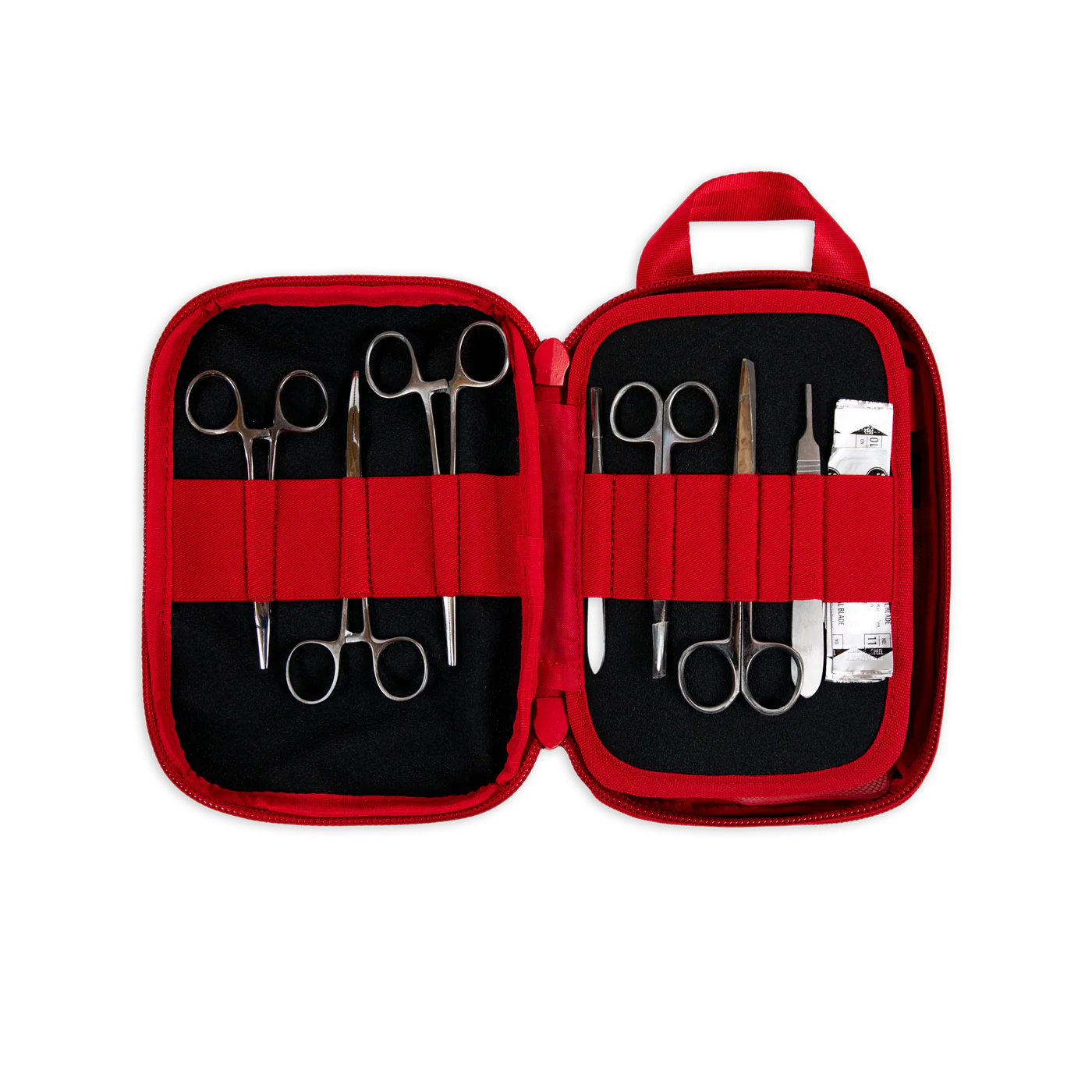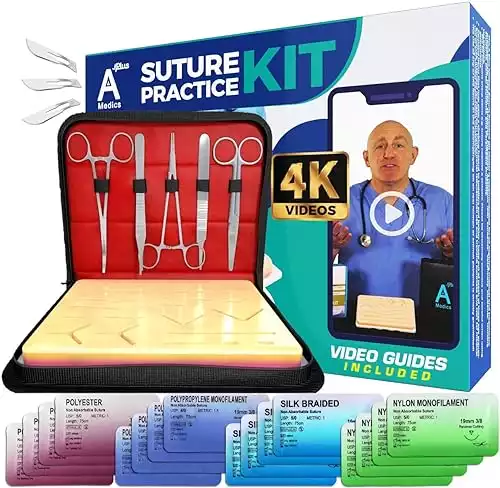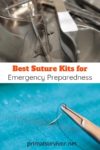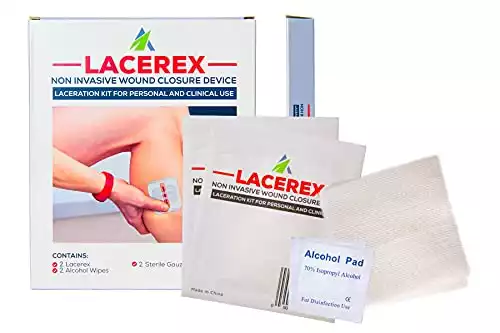In a do-or-die situation, you could get by stitching a wound with fishing hooks or a bent sewing needle. There are certainly many stories of field medics who’ve had to resort to these.
However, most of us would end up doing more harm than good with improvised stitching supplies.
Instead, be prepared by having a suture kit.
Unfortunately, there aren’t many suitable suture kits available for everyday people who simply want to be prepared. Here are the only two I’d recommend, as well as instructions on how to build your own.
Don’t Forget about Suture Alternatives
Unless you are entirely confident in your ability to suture a wound and can ensure that everything is sterile, stitching a wound might cause more harm than good.
Instead, consider using a suture alternative – such as wound closure strips.
 Wound Closure Kit | My Medic
Wound Closure Kit | My Medic
MyMedic is one of the best brands for first aid supplies. Their kits contain high-quality tools and are complete. Their Stitch Kit is no exception.
The Stitch Kit includes:
- Nylon sutures: One 3-0 suture and one 5-0 suture
- Needle driver: Clamps around the needle
- Scalpel blades + handle: 4 blades and handle
- Tweezers
- Surgical scissors
- Hemostats, x2: One straight and one curved hemostat
- Nitrile gloves x2
- EMT Shears
- Prep pads, x6
- Hand wipes, x2
- Saline vial, x2
- Antibiotic ointment, x2
- Gauze pads, x2
- Bandage, x2
- Liquid skin, x1
- Wound closure strips, x1 pack
- Designed to be used in the field.
- MOLLE case can be attached to your pack and easily opens
- All the suture supplies are easily accessible
- Has everything you’d need to suture a wound, including items for cleaning the wound
- Doesn’t contain tissue forceps
 Complete Suture Practice Kit for Medical Students
Complete Suture Practice Kit for Medical Students
This suture kit is designed for medical students and comes with a suture practice pad.
Despite being a practice kit, the instruments are good enough for real-life use.
The instruments aren’t packaged, though, so you would have to sterilize them before use.
The instruments aren’t great; it would be nice if the needle driver had fine teeth as the large teeth make gripping difficult, and the scalpels are annoying to get on the handle. However, it’s a good kit to have on hand “just in case” and to use while figuring out tool preferences.
The kit includes:
- Suture practice pad
- Iris scissors
- 3 scalpel blades
- Scalpel handle
- Hegar needle driver
- Adson toothed forceps
- Mosquito forceps
- 16 pre-loaded sterile nylon suture (4-0 size)
- Carrying case
- 16 sutures
- Practice pad
- Affordable
- Includes carrying case
- No other first aid items included
- Instrument quality could be better
3. Build Your Own Kit
Most of the suturing kits sold online are meant for training only. While the tools may look professional, they often have issues – such as the needle driver not making a “snap” sound when it is properly closed.
Thus, if you are serious about suturing and want high-quality items, you’ll probably have to build your own kit.
Here are high-quality suturing tools you can buy to build your kit.
Needle Driver:
- Cynamed Tungsten-Carbide Mayo Hegar needle driver: Check On Amazon
- HTI Tungsten-Carbide Mayo Hegar needle driver: Check On Amazon
Adson Tissue Forceps:
- Cynamed Adson thumb forceps: Check On Amazon
- HTI Adson thumb forceps, set of two: Check On Amazon
Suture Removal:
- MyMedic suture removal kit: Check On MyMedic
- Dynarex suture removal kit: Single-use disposable kit with hooked scissors, tweezers, and gauze – Check On Amazon
- Cynamed suture removal scissors: Check On Amazon
Choosing the Right Suture Kit
Learning how to suture wounds for emergency preparedness is suddenly trendy. As a result, many generic brands have started to sell suture kits. Many of these are less-than-ideal, mainly designed for “training” purposes.
While it might seem okay to practice with a cheap suturing kit, it’s not the smartest idea. The cheap tools and sutures might snag, have locking issues, or even break. Some cheap suture kits also include non-standard tools.
If you learn on these tools, you’ll have a hard time switching to actual medical-grade suture tools.
Before you buy a cheap suture kit for learning to stitch wounds, ask yourself these questions:
Do you need a case?
It’s nice to have all your suturing items together in a case. But, if you will put the items in another first aid bag, you might not need the case; you could buy the suturing items individually.
Also, consider whether the suture kit has room for more items, such as additional sutures or scissors.
Does the Suture Kit Contain Everything You Need?
For SHTF emergency prep, you probably don’t need a dozen different types of tools. The basics for suturing skin wounds are:
- Needle driver
- Pre-loaded sterile sutures: For skin wounds, sizes 2-0, 3-0, 4-0, and 5-0 are usually used
- Tissue forceps: They should be toothed and have a non-slip grip
- Scissors
Do You Need a Suture Removal Kit Too?
It’s possible to remove sutures with scissors and tweezers. However, it’s easier and safer to use a sterile suture removal kit. The scissors in these kits have a hook on one tip, which allows them to get under the suture to cut it easily.
How Many Sutures Are Included?
Most suture kits only have a few sutures included. You’ll need to purchase more separately. Note: if you are new to suturing, use cheap dental floss to practice with. Once you get comfortable with that and master knot-tying, move on to practicing with real suture.
Is There a Suture Practice Pad?
You can also practice suturing on items like grapes, pig feet, or chicken with the skin still on. However, suture practice pads are much easier to carry around and less messy.




I appreciate the fact that you provide pros and cons on all of these kits, and they helped me decide which way I would go with purchasing/making a kit. A BIG help was the section on Build Your Own Kit; providing the names of the suturing tools and where to find them gave me the option to customize my suture kit.
Glad you found it helpful 🙂 No kit is perfect so you will always have to customize the kit to a point. Next is just lots and lots of practice – and hopefully never having to use that knowledge!